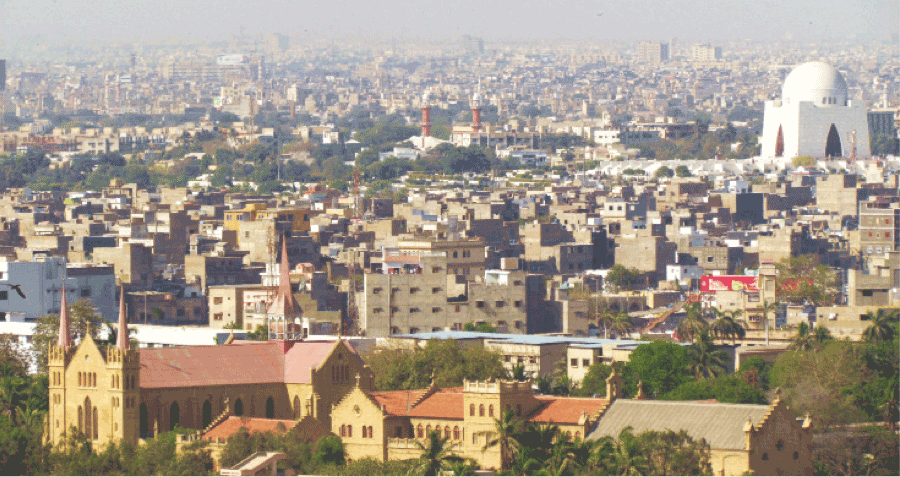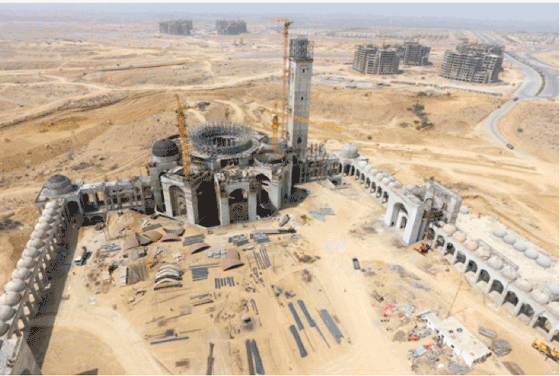Unplanned City
By Dr Noman Ahmed | Newsline Special | Published 6 years ago
The Karachi Strategic Development Plan (KSDP) 2020, which was prepared by the erstwhile City District Government Karachi (CDGK) more than a decade ago, is about to complete its assigned time period. In general, the key stakeholders are not concerned about the approaching expiration of this document. In recent times, however, many agencies and their heads are trying to find ways to save their skin from the repeated directives of the Supreme Court that intends to adjust Karachi according to a ‘plan.’

Interestingly, Karachi was never short of plans! Several development plans were prepared for the city before and after Partition. The British prepared the Mirams Plan in 1921, named after A. E. Mirams, a British surveyor who initiated it. The plan organised the historic quarters of Karachi. Municipal services were extended to these locations in a gradual manner. Col. Swayne Thomas, a British officer, prepared a plan in 1946 to establish future growth directions of the city.
However, due to partition of the subcontinent, the plan did not materialise. A Swedish firm, MRV Associates, prepared the Greater Karachi Plan in 1951. The plan outlined a location for accommodating capital functions for the city on the pattern of New Delhi. As the capital was shifted out of Karachi, the plan became largely ineffective, although some of the residential neighbourhoods proposed in this plan were later developed in what is the present day North Nazimabad.
The Greater Karachi Re-settlement Plan was prepared and implemented in 1958 to relocate the poor and working classes to specially planned sub urban locations of Landhi-Korangi and North Karachi. Two more comprehensive planning attempts produced the Karachi Development Plans (KDP) of 1973-85 and 1986-2000.

Karachi: City plans gone awry.
According to any technical standard, all of these plans were very sound initiatives. These plans recognised the unique status of the city, firstly as a primate city of the country and secondly as a mega city. It may also be pointed out that all the previous plans had tried to generate an intensive data base set of sectoral studies and analytical profiles. But these plans were never applied in letter and spirit for several reasons. It may also be pointed out that the true benefits of a viable planning mechanism cannot be achieved until some basic pre-requisites are fulfilled.
The first and foremost entity needed for Karachi is a legally and administratively autonomous planning agency. This is not a new suggestion. It is one of the key recommendations of KDP 1973-85. The exercise had also prepared a draft law for the consideration of the provincial legislature, which did not pay any heed to this important suggestion.
The need for such an agency is vital due to many reasons. Karachi is divided into multiple jurisdictions controlled by a jumble of local, provincial and federal agencies, including the military authorities. The impact of development (or the lack of it) in one locality has a direct bearing on the adjacent areas and even further.
Similarly, the responsibilities of infrastructure and services provision are divided between several bodies. Despite this schism, the creation of a unified vision and development plan remains paramount. A city plan can never see the light of implementation if the planning agency is not administratively, technically and financially potent.
This agency also needs to possess sufficient clout to enforce its writ on all the institutions and stakeholders on the basis of technical merit and jurisdictional validity. In other words, the agency must act as a filter to examine all the proposals of investment, project preparation and infrastructure development. Eminent planners and urban affairs specialists have ratified the importance of this proposed agency, but not much headway has been made.
A few years ago, the Government of Sindh (GoS) assigned the task of city planning to the Sindh Building Control Authority (SBCA). This was an inappropriate administrative move, as SBCA is supposed to follow the prescriptions of the planning agency. The Supreme Court of Pakistan has also stated its displeasure at this arrangement and has asked the GoS to rectify the situation.
Karachi has become a playground for all kinds of real estate investors. One reason for attracting this highly dubious portfolio of investment is the unaccounted land in the city. Every properly managed city possesses a land use strategy and a corresponding plan for its implementation. The reason is simple. Land is a finite social asset to be used in an extremely careful manner.
In the case of Karachi, this universal corollary is grossly violated.
The government decision-makers and agencies are also partners in crime. For example, precious suburban land along the Super Highway was allocated to a super developer for a mega investment venture. Straddling thousands of acres, a dubious real estate enterprise was created that attracted billions of rupees in investment.
In what is perhaps one of its kind judgements, the honourable Supreme Court allowed the realtor to continue functioning after paying a certain amount of monetary fine. Thousands of native tillers of soil, small-time livestock herders and orchard managers have been elbowed out from lands that they possessed for many years.
One fails to understand as to how any improvement in city management would be possible if the land reserves are sold out. A basic but fundamental exercise that needs to be done is to publicly announce land assets owned by various governmental agencies. This will help infuse transparency in transactions, leading to proper planning. It will also help to curb corruption by keeping a check on clandestine deals and allotments.
Karachi faces a grave crisis in respect of infrastructure provision, management and sustenance. One finds many high-profile projects undergoing different phases of implementation, but an impact is not found in holistic terms. The city is lacking in basic services including water supply, sewerage, storm water drains, public transport, electricity and social amenities. The common people are the worst-affected class.
 Good planning practices are based upon careful evaluation and assessment of ongoing trends. A sound planning framework aims to promote positive trends and control the negative ones. There are many visible trends in Karachi that have a direct bearing on urban life. Availability and investment of overseas capital into real estate enterprises; commodification of land assets; declining capacity of local government in fulfilling its mandated responsibilities; unchecked rise in vehicle ownership without concern about vehicle-road space ratio; inaccessibility of housing options for the poor, low- and middle-income groups; systematic destruction of ecological assets; falling standards in solid waste management, sewage and storm water disposal and a grant-dependent municipal finance system are some examples. Until these (and other) trends are professionally identified and examined for their intensity and impact, little good can be expected from municipal affairs.
Good planning practices are based upon careful evaluation and assessment of ongoing trends. A sound planning framework aims to promote positive trends and control the negative ones. There are many visible trends in Karachi that have a direct bearing on urban life. Availability and investment of overseas capital into real estate enterprises; commodification of land assets; declining capacity of local government in fulfilling its mandated responsibilities; unchecked rise in vehicle ownership without concern about vehicle-road space ratio; inaccessibility of housing options for the poor, low- and middle-income groups; systematic destruction of ecological assets; falling standards in solid waste management, sewage and storm water disposal and a grant-dependent municipal finance system are some examples. Until these (and other) trends are professionally identified and examined for their intensity and impact, little good can be expected from municipal affairs.
After the 18th Constitutional Amendment, the local government has become overly dependent upon provincial monetary allocations and transfers. The provincial government has its own agenda, which it is able to promote, given the financial clout and authority.
No municipal administration worth the name can function if it does not possess the financial capacity of self – generation of revenue. It is a complex domain but needs to be addressed for the larger benefit of the city. The first and foremost is the consolidation of existing taxes/levies. The local government institutions possess the mandate of many levies, which are under-collected for various reasons.
Let us look at the Karachi Water and Sewerage Board (KWSB). It has a relatively low rate of collection of its water bills. Even many government departments do not settle their water charges. The KWSB has been severely overburdened due to financial constraints of sorts. A formula can be worked out to salvage the cash-strapped utility. The next step should be to study the other taxations in the jurisdiction of provincial and federal governments. Legal and administrative options must be worked out to set up a pre-deposit formula for collection and transference of funds to the local institutions. And finally, the regime should also look towards new avenues of revenue generation.
Citizens suffer due to the absence of proper service standards and confusing procedures. Whether acquisition of a water connection or approval of building permits, the written procedures are either grossly inadequate or not existent at all. Public service counters and service booths must be opened to increase the scale of service. The sectoral or area performance must be studied to devise new systems. In order to improve the quality of life and increase the sphere of services, such actions possess undeniable significance. If strong and capable urban planning machinery is put in place, many of these issues will be effectively addressed.
There is a clear road map that may be devised and worked around. The Sindh Government should be asked to promulgate the necessary urban and regional planning act through the Sindh legislature without delay. The Supreme Court also desires this. A planning agency may be created with appropriate mandate and technical strength. This may take some time, but can only materialise when the first step is taken.
City boundaries may be drawn in order to determine accurate jurisdiction and service areas of various utilities. And a land information system should be devised and made publicly accessible to enable planners and other stakeholders to position themselves for various technical and strategic steps.


